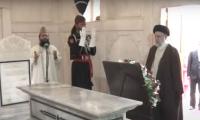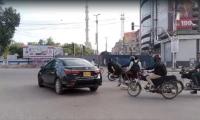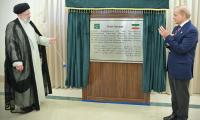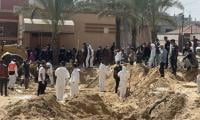PESHAWAR: Serious procedural violations have been identified during an investigation of the Peshawar Bus Rapid Transit (BRT), The News has learnt.
The inside story, narrated to the scribe by an official on the condition of anonymity, revealed that a politically motivated project was launched in haste, without acquiring a detailed design. From the day one, all activities were conducted in a haphazard manner, which resulted in construction of useless structures, which could not be properly utilised.
However, the Peshawar Development Authority (PDA) has submitted 20-page point-wise replies to the objections, raised by the Peshawar High Court (PHC). The court had raised 58 points and 35 questions regarding the project.
The PDA reply claimed that the project was properly planned, a feasibility study was conducted, a preliminary engineering design in the beginning, and a detailed engineering design later on, were prepared, and the per kilometre cost of the main corridor was estimated at only Rs1.04 billion.
The PDA stated that a proper pre-feasibility was also conducted by the Cities Development Initiative for Asia (CDIA), jointly supported by the Asian Development Bank (ADB), German and Swedish Development authorities, through a grant of $372,000 and was completed in May 2014.
Subsequently, a feasibility study was conducted by the Desain Mobilitas Indonesia, the BRT Planning International and Think Transportation through a grant of $0.5 million, which was completed in January 2017. Thus, prior to execution of the project, pre-feasibility and feasibility studies as well as preliminary engineering design were available.
The original PC-I (project cycle-1) was based on the preliminary engineering design and the feasibility report, which had already been completed and were available at the time of PC-I preparation.
The PC-I was discussed in the Provincial Development Working Party (PDWP) meeting on March 28, 2017, and was recommended for approval at a cost of Rs56.80 billion. However, the Central Development Working Party (CDWP) and the Executive Committee of the National Economic Council (Ecnec) approved the same at a reduced cost of Rs49.453 billion in their meetings, held on May 3, 2017 and July 10, 2017, respectively.
Revision of the PC-I was undertaken primarily due to increased scope of work and inclusion of an additional co-financer i.e. the Agence Française de Développement (AFD).
Keeping in mind the above mentioned claims, it is very important to note that the actual amount of loan so committed i.e. $335 million by the ADB and €130 million by the AFD had remained the same, and not changed at all.
The PDA said that the basic reason for changes in design was social demands, site constrains and enhancement of work scope. The Mott Macdonald developed the preliminary design, prepared by the Project Preparation Technical Assistance (PPTA) into a detailed design, which was vetted and approved by the third party design review consultant and also by a committee, notified by the provincial government that included representation from different departments such as Communication and Works (C&W), Irrigation, Public Health, etc. The Mott Macdonald was assigned the task by the Asian Development Bank and not by the PDA.
Sources said the senior officers of the provincial government, who were provided with the BRT project allowance, were exclusively those who remained engaged in the project most actively and beyond the official hours of duty. The allowances were allowed by the PDA Board and the provincial cabinet and was part of the revised PC-1, recommended by the PDWP and the CDWP and approved by Ecnec.
As per the project administration manual (PAM) of the ADB, the Transport Department is the executing agency, while the PDA is the implementing agency for the project. As such, since the PDA had the relevant expertise in construction, the implementation part was given to it.
Regarding per kilometre cost, the PDA simplified that the said amount calculated did not only include the construction of corridor but also construction of three depots, purchase of buses, installation of ITS system, land acquisition and social rehabilitation, fleet procurement, consultant supervision cost, etc. The report further said that the comparison of potential riders between Peshawar and Lahore was not justified owing to the fact that Lahore had a multitude of alternative routes within the city, While in Peshawar, the GT-Jamrud Road is rather an exclusive road artery for commuting.
The subsidy will be in place for the first three years of operation, after which the operation is envisaged to go into positive cash flow and provision is made accordingly for loan repayment. The forecast is quite realistic and based on factual data and statistical calculations, the report claimed.
Mott Macdonald International Ltd is an international consultancy operating in Europe, Asia, Africa, America and Australia with more than 40,000 professional engineers in its employment. The award of the consultancy was carried out through international competitive bidding process through the ADB. There were no flaws in the design and site adjustment was carried out during the course of the project as is normal practice in all civil engineering projects.
“Mr Durrani was actually terminated (not made to resign) based on his poor performance and incompetence. Mr Durrani later on challenged the decision of his termination in the Peshawar High Court and the Supreme Court, which was decided in the government’s favour,” the report added.
The PDA said that the ADB objected to the high-level barriers, which were initially included in the design. Accordingly, several proposals for the fence were submitted to the ADB. Finally, the existing design was approved and the same had been executed on site.
The PDA stated that the elevated structure at Tehkal Area, the design was changed on public demand and agitation for a U-turn provision. At the University Road, most of the underpasses had been constructed on build–operate–transfer (BOT) basis. Accordingly, removal of the same would require bearing of an additional hefty cost of social resettlement, apart from potential litigations.
The PDA stated that initially the curves were designed for the operational speed of 10-km/hour. Later on, upon the demand of the ADB, the curves were accordingly adjusted in order to provide for a speed of 20-25km/hour. Necessary alteration has been made without any further financial implication on the project cost. The decision to procure 220 busses was taken keeping in view the requirements of the project, based on statistical analysis.
Hospital management responded that only one post of BS-19 was vacant which is to be filled through direct recruitment
PMLN does not have a mandate from the people for privatising the SOEs: says Rabbani
Administrative Service Ali Hussain Malik and made him OSD in the Establishment Division
Establishment Division had notified Rizvi’s appointment as IGP Islamabad on March 30, but the Punjab government...
A British citizen of Pakistani origin has lodged formal complaint against FIA officer, alleging torture during a...
Former COAS admitted the army extended full support to Imran Khan’s government







